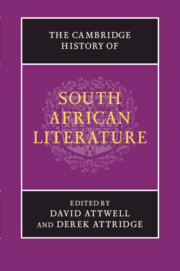Book contents
- Frontmatter
- Introduction
- PART I ORATURES, ORAL HISTORIES, ORIGINS
- PART II EXPLORATION, EARLY MODERNITY AND ENLIGHTENMENT AT THE CAPE, 1488–1820
- 6 Shades of Adamastor: the legacy of The Lusiads
- 7 In the archive: records of the Dutch settlement and the contemporary novel
- 8 Eighteenth-century natural history, travel writing and South African literary historiography
- PART III EMPIRE, RESISTANCE AND NATIONAL BEGINNINGS, 1820–1910
- PART IV MODERNISM AND TRANSNATIONAL CULTURE, 1910–1948
- PART V APARTHEID AND ITS AFTERMATH, 1948 TO THE PRESENT
- PART VI SOUTH AFRICAN LITERATURE: CONTINUITIES AND CONTRASTS
- Index
- References
8 - Eighteenth-century natural history, travel writing and South African literary historiography
from PART II - EXPLORATION, EARLY MODERNITY AND ENLIGHTENMENT AT THE CAPE, 1488–1820
Published online by Cambridge University Press: 28 January 2012
- Frontmatter
- Introduction
- PART I ORATURES, ORAL HISTORIES, ORIGINS
- PART II EXPLORATION, EARLY MODERNITY AND ENLIGHTENMENT AT THE CAPE, 1488–1820
- 6 Shades of Adamastor: the legacy of The Lusiads
- 7 In the archive: records of the Dutch settlement and the contemporary novel
- 8 Eighteenth-century natural history, travel writing and South African literary historiography
- PART III EMPIRE, RESISTANCE AND NATIONAL BEGINNINGS, 1820–1910
- PART IV MODERNISM AND TRANSNATIONAL CULTURE, 1910–1948
- PART V APARTHEID AND ITS AFTERMATH, 1948 TO THE PRESENT
- PART VI SOUTH AFRICAN LITERATURE: CONTINUITIES AND CONTRASTS
- Index
- References
Summary
Travel writing in South Africa in the eighteenth and early nineteenth centuries was a highly self-conscious genre, aimed at the European elite, and closely linked to the leading intellectual and political movements of its time. Its major protagonists came from a variety of countries and many were major figures in scientific discovery. The German Peter Kolb(e)(n) (1675–1725/6) and Frenchman Nicholas Louis de La Caille (Delacaille, de la Caille, De Lacaille) (1713–62) were astronomers; the Swedes Anders Sparrman (1748–1820) and Carl Thunberg (1743–1828) were naturalists with a particular interest in botany; the Scot William Paterson (1755–1810) was a soldier and botanist; the Surinamborn Frenchman François Le Vaillant (also known as Levaillant) (1752–1824) was primarily an ornithologist. Other figures had strong links to colonial administration: Johannes de Grevenbroek was the secretary of the Dutch East India Company Political Council at the Cape in the late seventeenth century; Robert Gordon (1743–95) was of Scots origin but working for the Dutch government as a military commander at the Cape; while the Englishman John Barrow (1764–1848) was a geographer and colonial civil servant with a strong interest in land surveying. There were other important travel writers, notably the only important female figure, Lady Anne Barnard (1750–1825), wife of the British Governor in the late eighteenth and early nineteenth centuries, whose work has enjoyed more attention than any of the other figures although her diaries remained unpublished until the twentieth century.
- Type
- Chapter
- Information
- The Cambridge History of South African Literature , pp. 158 - 180Publisher: Cambridge University PressPrint publication year: 2012
References
- 11
- Cited by

